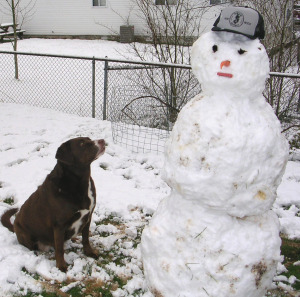It’s the end of the year and no one is in the mood to be at work so here is a Holiday Hypothetical to brighten your day!
Hypothetical:
“Frosty the Snowman” needed a holiday gift for Mrs. Frosty so he slid down the hill and into a nearby store. Frosty had a difficult time picking out the perfect scarf to match his wife’s beautiful eyes. After about 20 minutes, he found the one he wanted, bought it and left the store. Unfortunately for Frosty and the store, Frosty weighed about 5 pounds lighter when he left because the store was a balmy 68 degrees inside.
Is the puddle of water in front of the scarf display left by Frosty a natural or unnatural accumulation?
Analysis:
If you went to law school, this is just the type of wild and crazy discussion you had during first year with your classmates at the bar on a Friday afternoon. If you did not go to law school, this hypothetical is more evidence that lawyers are boring at parties (and a little weird).
That being said, let’s evaluate this from both perspectives. Assume Frosty was shopping in a Chicago suburb so Illinois law and the natural accumulation doctrine applies.
Plaintiff’s Attorney’s Perspective / Unnatural Accumulation
Everyone knows that a bunch of kids made Frosty. Snowflakes did not fall from the sky and miraculously create a snowman. The fact that he was built by hand, automatically makes him an unnatural accumulation because he is not inherently natural.
In Illinois, “Plaintiffs may rely upon the reasonable inferences which can be drawn from the facts considered on the motion for summary judgment in determining whether a genuine issue of material fact exists.” Gehrman v. Zajac, 34 Ill.App.3d 164, 166 (1975). To withstand summary judgment, the plaintiff has to show that the origin of the ice was unnatural or created by the defendants. Branson v. R & L Investment, Inc., 196 Ill.App.3d 1088, 1094 (1990). Additionally, the cause of the unnatural accumulation or aggravated natural condition must be “identifiable.” Id.
The cause of this unnatural accumulation is clearly identifiable, it is a puddle caused by a snowman created by children. Therefore, Frosty’s puddle is an unnatural accumulation.
Defense Attorney’s Perspective / Natural Accumulation
The plaintiff is correct, Frosty was created by children. However, it is not Frosty that we are talking about, it is a puddle of water left by Frosty. That puddle of water was created from snow. The snow was not created or altered by the store. Therefore, the puddle is a natural accumulation even if Frosty himself is unnatural.
In the alternative (because the defense always needs an alternative argument), even if the puddle was an unnatural accumulation, the store could not be found liable for it, and that is the real issue.
A defendant cannot be held liable for injuries sustained unless a plaintiff shows that the defendant aggravated a natural condition or that the origin of the accumulation of ice, snow, or water was unnatural. Branson v. R & L Investment, Inc., 196 Ill.App.3d 1088, 1091 (1990). If the landowner or a hired contractor creates an unnatural accumulation, then liability may attach as a result of failing to use ordinary care. Id. The fact that snow has been cleared and that there are piles of snow present suggests that the snow piles are an unnatural accumulation. Krywin v. Chicago Transit Authority, 238 Ill.2d 215, 231-32 (2010).
For a plaintiff to recover in a slip-and-fall case involving ice, snow, or water, the plaintiff must show “that the accumulation of ice, snow or water is due to unnatural causes and that the property owner had actual or constructive knowledge of the condition.” Gilberg v. Toys “R” Us, Inc., 126 Ill.App.3d 554, 557 (1984). The plaintiff must “show that the accumulation was somehow created by defendants or that the property owner had actual or constructive knowledge of the condition.” Bloom v. Bistro Restaurant Ltd. Partnership, 304 Ill.App.3d 707, 711–12 (1999).
The store did not create Frosty or the puddle so notice of the puddle is required. Frosty was in the store for only 20 minutes and the puddle would not have started to develop until he had been there awhile. It would not have been noticeable until he left the area. Therefore, there is a strong argument for constructive notice (depending on when the hypothetical fall took place).
Answer:
Since I am the judge, jury and professor here, I rule for the defense. I like the originality of the defense’s natural accumulation argument but in the end, what really matters is if the store could be found liable and here, there is a great argument that it could not. Plus, who wants to end the year with a defense loss!
Wishing you and your company a Happy Holiday and New Year! – And many defense wins!
Stacy Fulco